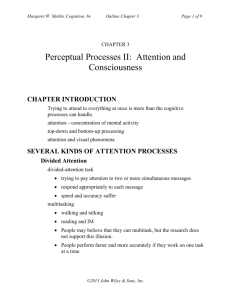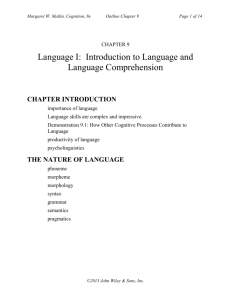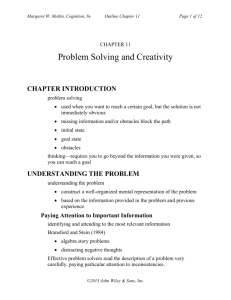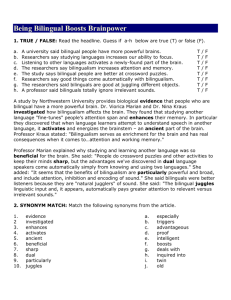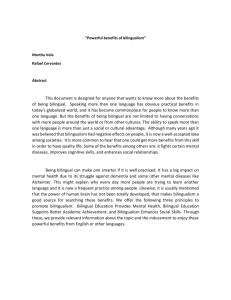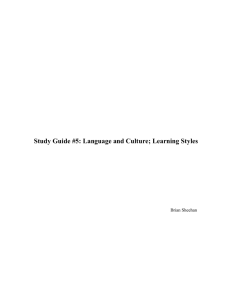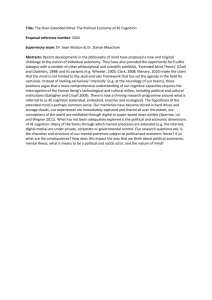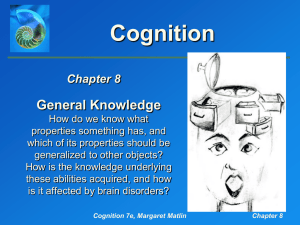Writing
advertisement
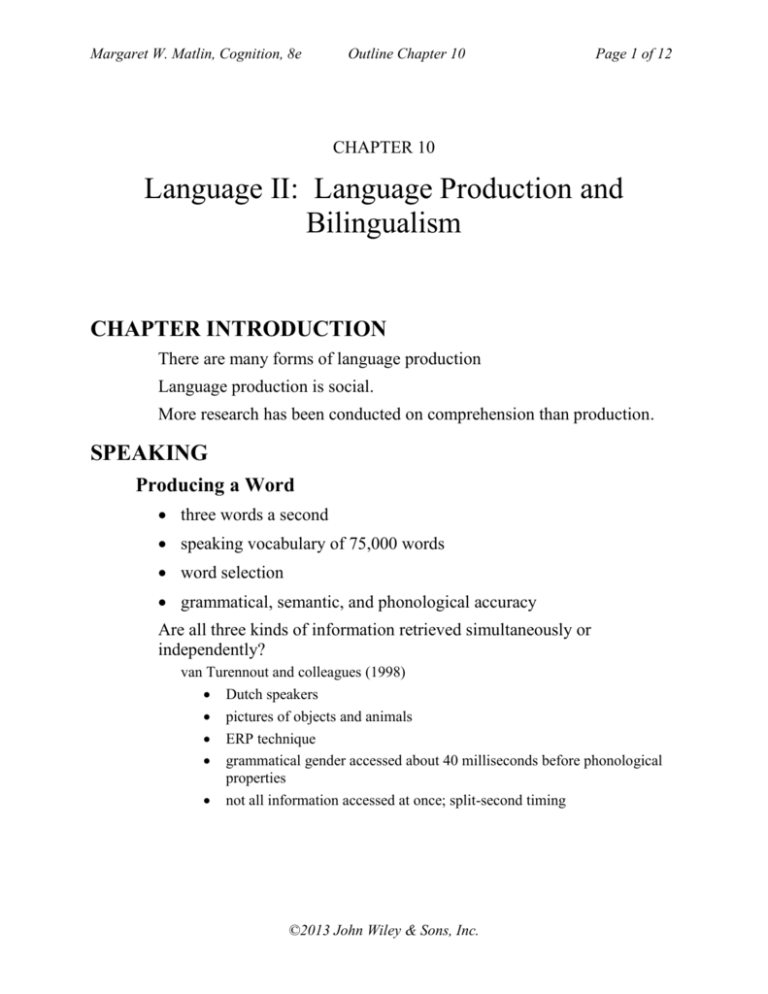
Margaret W. Matlin, Cognition, 8e Outline Chapter 10 Page 1 of 12 CHAPTER 10 Language II: Language Production and Bilingualism CHAPTER INTRODUCTION There are many forms of language production Language production is social. More research has been conducted on comprehension than production. SPEAKING Producing a Word three words a second speaking vocabulary of 75,000 words word selection grammatical, semantic, and phonological accuracy Are all three kinds of information retrieved simultaneously or independently? van Turennout and colleagues (1998) Dutch speakers pictures of objects and animals ERP technique grammatical gender accessed about 40 milliseconds before phonological properties not all information accessed at once; split-second timing ©2013 John Wiley & Sons, Inc. Margaret W. Matlin, Cognition, 8e Outline Chapter 10 Page 2 of 12 Speech Errors Speech is generally accurate and well-formed. slips-of-the-tongue—errors in which sounds or entire words are rearranged between two or more different words Types of Slip-of-the-Tongue Errors 1. Sound errors 2. Morpheme errors 3. Word errors Characteristics Errors create a word, rather than a non-word. Errors reveal our extensive language knowledge. Errors tend to occur across items from the same category. Words we are currently pronouncing are influenced by both the words we have already spoken and the words we are planning to speak. Explanations for Speech Errors Dell and colleagues comprehensive theory for speech errors similar to connectionist approach spreading activation Planning activates sound elements. Each sound can be activated by several different words. High activation can cause the incorrect sound to be produced. ©2013 John Wiley & Sons, Inc. Margaret W. Matlin, Cognition, 8e Outline Chapter 10 Page 3 of 12 Using Gestures: Embodied Cognition gestures cultural differences Gestures can influence how you think. Frick-Horbury & Guttentag (1998) identifying target word from definition hand movements restricted or unrestricted Participants with unrestricted hand movements identified more words than those with restricted hand movements. When our verbal system cannot retrieve a word, a gesture can sometimes activate the relevant information. Demonstration 10.2: Using Gestures to Communicate Information Some concepts are easier to describe with body movements than with words. People are more likely to produce a gesture when they have had previous experience with the relevant physical activity. Embodied cognition People use their bodies to express their knowledge. ongoing connection between motor system and processing spoken language importance of concrete physical actions, rather than abstract meaning Hostetter (2011)—meta-analysis Do gestures actually help us in communicating a message? Gestures actually do increase the listener’s understanding, especially when the speaker is describing concrete actions. Producing a Sentence Limits of attention and memory 1. Plan the gist 2. Devise general structure of sentence 3. Choose specific words and grammatical form 4. Convert these intentions into speech Stages of sentence production overlap in time. linearization problem—transforming general thought or mental image into an ordered, linear sequence of words prosody—"melody," intonation, rhythm, emphasis ©2013 John Wiley & Sons, Inc. Margaret W. Matlin, Cognition, 8e Outline Chapter 10 Page 4 of 12 Producing Discourse discourse—language units larger than a sentence narrative—type of discourse in which someone describes a series of actual or fictional events Characteristics of narrative time-related sequence emotionally involving goal to convey words chosen carefully entertaining Narrative structure 1. 2. 3. 4. 5. 6. Brief overview Summary of characters and setting Complicating action Point Resolution Final signal that the narrative is complete In Depth: The Social Context of Language Production Language as a social instrument Speakers must consider their conversation partners coordinating turn-taking agreed meanings intentions pragmatics—social rules and world knowledge that allow speakers successfully communicate messages to other people ©2013 John Wiley & Sons, Inc. Margaret W. Matlin, Cognition, 8e Outline Chapter 10 Page 5 of 12 In Depth: The Social Context of Language Production (continued) Common Ground common ground—occurs when conversationalists share similar background knowledge, schemas, and perspectives necessary for mutual understanding collaborate pay attention assess background knowledge clarify misunderstandings Clark and Wilkes-Gibbs (1986)—Demonstration 10.4 pairs of participants arranging figures in order mutual shorthand and shared vocabulary developed number of required turns decreased rapidly over trials conversational partners become more skilled in communicating efficiently physicians and patients Speakers often overestimate their listeners' ability to understand a message. Directives directive—a sentence that requests someone to do something direct request indirect request Framing George Lakoff Language can structure thinking. frame—mental structures that simplify reality example: individual vs. social responsibility When people have different frames, it may be difficult to talk with others about many important contemporary issues. ©2013 John Wiley & Sons, Inc. Margaret W. Matlin, Cognition, 8e Outline Chapter 10 WRITING Writing requires virtually every cognitive process. One of the least-researched linguistic tasks Frequency of writing activities Similarities and differences between writing and speaking Writing: is done in isolation takes more time uses more complex syntax is revised more Social factors are more central in speaking than in writing. Three phases planning sentence generation revising Strains on attention Role of practice Importance of drafts ©2013 John Wiley & Sons, Inc. Page 6 of 12 Margaret W. Matlin, Cognition, 8e Outline Chapter 10 Page 7 of 12 The Cognitive Components of Writing Working Memory Kellogg and colleagues (2007) Students wrote definitions for words while working on a secondary task at the same time. Researchers examined possible interference from phonological, visual, and spatial tasks. phonological loop task (remember a spoken syllable) When the students were writing, they required significantly longer to remember the syllables. The phonological loop seems to be an important factor when we write. visuospatial sketchpad tasks visual information (remember the visual shape of an item): When students were writing about concrete nouns, they required significantly longer to remember the item's visual shape. When writing about abstract nouns, no delay in remembering the item's visual shape. spatial information (remember a particular location): Students' reaction times not affected by the writing task. Writing does not require us to emphasize locations (spatial information). central executive active in virtually every phase of the writing process coordinates planning involved in sentence generation oversees revision limited capacity can make writing a stressful task Long-Term Memory semantic memory expertise schemas knowledge about writing style required ©2013 John Wiley & Sons, Inc. Margaret W. Matlin, Cognition, 8e Outline Chapter 10 Page 8 of 12 Planning a Formal Writing Assignment prewriting generating a list of ideas difficult and strategic large individual differences Good writers are more likely than poor writers to spend high-quality time planning. outlining avoids overloaded attention resolving linearization problem Sentence Generation During Writing translate the general ideas (developed during planning) into actual sentences of the text hesitant phases and fluent phases longer vs. shorter words Writing errors are most likely to be spelling errors within a single word rather than between-word errors. The Revision Phase of Writing Emphasize the importance of organization and coherence. Reconsider whether the writing accomplishes the goals of the assignment. Revision should be time consuming. Effective writers use flexible revision strategies, and they make substantial changes. College students typically devote little time to revising. Metacognitions about the writing process seem to be inaccurate. ©2013 John Wiley & Sons, Inc. Margaret W. Matlin, Cognition, 8e Outline Chapter 10 Page 9 of 12 The Revision Phase of Writing (continued) Hayes and colleagues (1987)—experts vs. novices first-year college students vs. expert writers revise a poorly written two-page letter Novices revise sentence-by-sentence; focus on spelling and grammar. Experts work more on organization, focus, and transition between ideas. Novices judge defective sentences as appropriate. Experts are better able to diagnose the source of a problem in a sentence. Daneman & Stainton (1993)—proofreading difficult to proofread your own writing proofread for spelling separately from content wait at least one day, after revising content, to proofread for spelling BILINGUALISM AND SECOND-LANGUAGE ACQUISITION Many people throughout the world have mastered two or more languages. bilingual speaker—a person who is fluent in two different languages multilingual speaker simultaneous bilingualism sequential bilingualism, first language, second language Background on Bilingualism More than half of the people in the world are at least somewhat bilingual. People become bilingual for many reasons. Tables 10.1 & 10.2: Languages Most Frequently Spoken at Home in the United States and Canada For many people in North America, English is not the language most frequently spoken at home. ©2013 John Wiley & Sons, Inc. Margaret W. Matlin, Cognition, 8e Outline Chapter 10 Page 10 of 12 The Social Context of Bilingualism Even though many children in the United States and Canada speak a language other than English in their homes, the educational system frequently does not value this other language. If a school values a child's first language, he or she may actually become more fluent in English. Success in acquiring a second language is related to individual motivation attitude toward people who speak that language Language proficiency can also influence attitudes. Danziger and Ward (2010) Arab Israeli students fluent in both Arabic and Hebrew Implicit Association Test (IAT) The Arab students were more positive about Jewish individuals when the fluently bilingual researcher was speaking Hebrew, than when she was speaking Arabic. Advantages (and Minor Disadvantages) of Bilingualism Advantages 1. Bilinguals actually acquire more expertise in their native (first) language than do monolinguals. 2. Bilinguals are more aware that the names assigned to concepts are arbitrary. Also outperform monolinguals on many other measures of metalinguistics. 3. Bilinguals excel at paying selective attention to relatively subtle aspects of a language task, ignoring more obvious linguistic characteristics. 4. Bilingual children are better at following complicated instructions and performing tasks where the instructions change from one trial to the next. 5. Bilinguals perform better on concept-formation tasks and on tests of nonverbal intelligence that require reorganization of visual patterns. Bilinguals also score higher on problem-solving tasks that require them to ignore irrelevant information. 6. Bilingual children are more sensitive to some pragmatic aspects of language. 7. Bilingual adults who have dementia typically develop signs of dementia later than monolingual adults with dementia. ©2013 John Wiley & Sons, Inc. Margaret W. Matlin, Cognition, 8e Outline Chapter 10 Page 11 of 12 Advantages (and Minor Disadvantages) of Bilingualism (continued) Disadvantages People who use two languages extensively may subtly alter how they pronounce some speech sounds in both languages. Bilingual individuals may also process language slightly more slowly, in comparison to monolinguals. Bilingual children may have somewhat smaller vocabularies for words that are used in a home setting. Disadvantages far outweighed by advantages of begin able to communicate effectively in two languages. Second-Language Proficiency as a Function of Age of Acquisition age of acquisition critical period hypothesis Vocabulary When the measure of language proficiency is vocabulary, age of acquisition is not related to language skills. Phonology Age of acquisition does influence mastery of phonology (sounds of speech). Flege and coauthors (1999) Korean-Americans Degree of accent related to age of arrival: Immigrants arriving as children had minimal accents; those who arrived as adolescents or adults had stronger accents. fairly smooth change over age rather than abrupt drop Grammar Flege and coauthors (1999) judging English sentences as grammatical After controlling for years of education in the United States, age of acquisition was not related to an individual's mastery of English grammar. Studies with other languages—no consistent relationship between age of arrival and mastery of English grammar ©2013 John Wiley & Sons, Inc. Margaret W. Matlin, Cognition, 8e Outline Chapter 10 Page 12 of 12 Individual Differences: Simultaneous Interpreters and Working Memory translation—converting a text written in one language into a second written language interpreting—converting a spoken message in one language into a second spoken language Simultaneous interpretation involves three working-memory tasks at the same time (comprehension, transformation, speak out loud). Christoffels, De Groot, and Kroll (2006) Dutch/English speakers—students, teachers of English, simultaneous interpreters reading-span test and speaking-span test All groups recalled more words in their native language (Dutch) than in their second language (English). Simultaneous interpreters remembered significantly more Dutch and English words than the other two groups, both in reading span and in speaking span. Possible Explanations The experience of managing simultaneous tasks actually increased the working-memory skills for the simultaneous interpreters. Only people with superb working-memory skills can manage to survive in a profession that requires an extremely high level of proficiency in working memory. Both of these explanations may be correct. ©2013 John Wiley & Sons, Inc.
